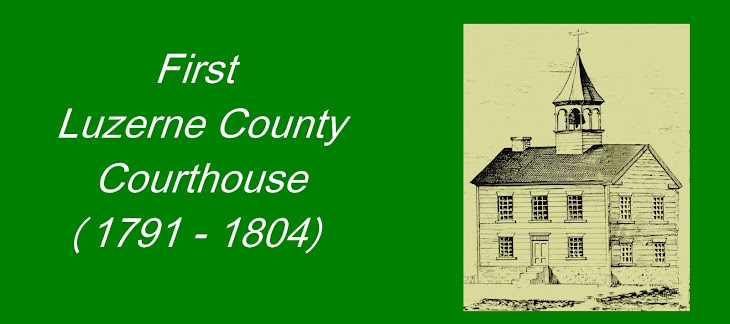Back to Luzerne County Courthouses
The Act of Assembly forming Luzerne county, named Zebulon Butler, Jonah Rogers, Simon Spaulding, Nathaniel Landon, and John Philips, as trustees to locate and to erect a court house and jail. This they did, on the site of the old fort in the public square in Wilkes- barre. This building was about 25 by 50 feet, constructed of hewn logs, two stories high, with outside steps leading to the court room on the second floor. The first story was used as a jail and the jailor's residence. This primitive temple of justice was completed in 1791, and Stephen Tuttle, whose good wife placed her cake and beer sign over the door of the first story, was appointed first jailor.
On one occasion, during the sitting of the Supreme Court, an unusual noise disturbed his Honor, Judge McKean, who, in a stern voice, commanded silence. The noise, however, continued, when the court sent for Mr. Tuttle, who, evidently much incensed, informed his honor that the damned hogs had got at his corn in the garret by coming up the outside steps in the morning. Mr. Tuttle was ordered to eject the intruders forthwith. There proved to be but one hog, which rushed forth with a tremendous grunt, capsizing Mr. Tuttle, together with the gravity of the court. After a few years, it was resolved to erect a new building for the courts.
In 1801, Lawrence Myers, Eleazar Blackman, and Thomas Wright, county commissioners, procured the plan of a court-house, in Fredericksburg, Maryland, for which they paid $17.06.
The old log court-house was removed by Joseph Hitchcock, the contractor for the construction of the new edifice, but it continued to be occupied by the courts until 1804, when the new building was completed, and the old one was converted into the Wilkes-Barre Academy. This new structure, in the form of a cross, declared by the commissioners to be " most elegant and convenient," was erected on the site of the old log courthouse.
(Stewart Pearce)
Tuesday, February 24, 2009
Subscribe to:
Posts (Atom)
